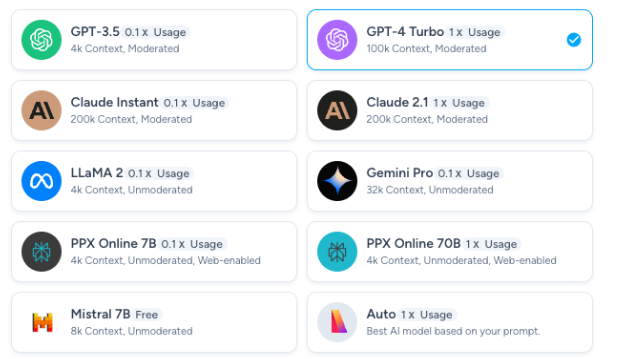
Freaking Out About AI? Here’s Why You Shouldn’t
Shiny new AI tools and applications seem to be released every day, and they’re constantly shaking up the way we marketers do our jobs.
So, it’s completely understandable that many of us feel overwhelmed as we struggle to make sense of how to use this new(ish) technology to our advantage.
Here are some tips and tricks to help you make sense of AI, understand its current use cases, and alleviate the stress that often comes with adopting new technology.
Embrace the “There’s an AI Bot for That” Mentality
Assuming you’re old enough, you may remember when the iPhone first started to take off; many developers were rushing to develop apps for the App Store.
Now, apps are commonplace, and whatever we used to do manually, we now have a corresponding app to get the job done – for better or worse.
The same applies when it comes to the broadened use of AI in our daily lives. There is an App for that. Well, there is an AI Bot for that.
Once you accept that there’s an AI Bot for many of the tasks in your job role, you’ll be like, OK, I can deal with that.
Then, it’s up to you to determine what AI tools you want to use.
And if you’re not totally comfortable with fully embracing AI just yet, or you feel like you’re late to the game, there’s no need to worry; new and better AI tools are released daily, and there’s no wrong time to dive in.
In other words, take a deep breath – everything is going to be okay.
You are not late to the party.
Each LLM May Provide Recommendations a Little Differently
Current AI is based on various versions of LLMs (Large Language Models) from Open AI, Microsoft, Google, Meta, and other companies.
LLMs are very large deep-learning models that are pre-trained on vast amounts of datasets that companies gather from open sources such as books, articles, websites, and other information. Therefore, each LLM may give you different recommendations based on the datasets.
This is no different than the varied search results you receive if you use Google Search, Microsoft Bing, or any other search engine.
But at the end of the day, the common theme is that each of these LLMs can tap into their own sources to give you the best results.
GPT is the most popular and well-known LLM from Open AI, but below is a list of various AI LLM Models:
I am often asked which is better. Well, it depends.
You can try various AI models to see the differences. Magai actually allows you to test different AI models when you enter the same prompts.
Or, just stick to the one that you use the most.
Genuinely, it’s all good.
The Importance of Effective Prompts
With AI tools advancing at lightning speed, crafting effective prompts has become an essential skill for success. OpenAI’s latest model, Sora – the most advanced text-to-video tool, which makes prompts even more critical to get the most miles out of AI.
To demonstrate the incredible possibilities and results of good prompts, I have carefully selected a range of examples featuring many videos found on Twitter (yes, I still call it that 🙂 ).
This video was generated by Sora.
That's the new model by OpenAI. The most advanced text-to-video tool created so far.
I'll share the videos here. Absolutely insane.
Prompt: This close-up shot of a Victoria crowned pigeon showcases its striking blue plumage and red chest. Its… pic.twitter.com/ktvReYWvGZ
— Eduardo Borges (@duborges) February 15, 2024
OpenAI just introduced SORA: new text2video #AI model.
While everyone is just posting mind-blowing examples, I want to talk about the consequences.
A thread 🧵🔽 pic.twitter.com/wyYx0PsS2o
— Denis Rossiev ᯅ/acc (@Enuriru) February 15, 2024
🚨 Good Bye Reality
Every single video in this thread was generated by Open AI's new text to video model "Sora" 🤯
🧵
1/48 pic.twitter.com/ze4Mom2Bgs— Sambhav Gupta (@sambhavgupta6) February 15, 2024
Many marketers have been using ChatGPT or other AI chat tools to create blogs, summarize content, and write emails.
Some of my clients have even created a short marketing or campaign plan by giving very detailed instructions, almost like writing a little briefing sheet to update agencies or freelancers.
They still need to modify ChatGPT’s suggestions to ensure everything is accurate and makes sense, but it’s a solid starting point for a draft that they can work with.
In fact, that’s how you should think about prompts: how can you provide specific, relevant, and actionable information so that AI knows what to do specifically to give exactly what you envision?
Here are 3 prompt examples:
- Help me write a marketing plan
- Help me write a marketing plan for a commercial bank
- Help me write a marketing plan for a commercial bank. Its unique value proposition is ________. Its target customers are ______________. The plan needs to include campaign plan recommendations with specific marketing channels such as ______,_____,_____.
When you write your prompts, think through how you brief your agencies and freelancers before they start. That’s what you need to do for your prompts.
It takes time to learn to write good prompts. The mindset you need to have is to explain what you are looking for in many different ways to AI. Give AI enough and specific information (not to overwhelm AI) to tailor its response for you.
This is true, especially when you try to write sophisticated prompts. I love reading prompts that people create on midjourney. Reading others’ prompts is a good way to learn how to write effective prompts.
I often think by the time we are done with our trial-and-error with AI, we will be better communicators with AI than with real humans. LOL.
Scalability and Integration Challenges
This is probably the easiest and hardest part at the same time. Hear me out, though.
The easiest part is that if you have one task in mind for enlisting the help of AI (for example, maybe you want to find a tool to create three video shorts of an existing long-form video), it’s pretty simple to find the best tool to use for the job.
You can search for an AI tool to create video shorts using an existing long-form video. Many AI applications will likely come up, but then you just need to do your research, read comments, and test them out.
BTW, I really like Opus Clip, but there are many other similar tools.
So, you know your task, you find the tool. That’s easy!
But now, here comes the hardest part. Say, for example, that you want to find a video editing tool, but you also want the tool to integrate into your existing workflows and want to automate that.
Then, your single task of searching for an AI tool becomes a complicated question of scalability and back-end integration.
Suddenly, it’s no longer about completing one task using one AI tool. Suddenly, you need to think about:
Does this tool comply with certain security standards?
Can this tool be integrated with your existing tools?
Who should get involved if we need to integrate AI-based tools?
What are some company legal policies that we need to be aware of?
And more…
Thinking about how to scale AI and incorporate AI as part of existing workflows is something we are all struggling with.
Again, take a breath.
This can’t be solved in a few days or even a few months. Just be patient and take one (baby) step at a time.
The Learning Curve of AI Tools
Setting aside the AI back-end integration for now, let’s just focus on one-task-oriented AI tools.
Say you find the ideal AI tool to complete your tasks you need to then take the proper time to test and learn it.
It takes time to be good at a certain tool, no matter how intuitive the platform is.
Suddenly, the trade-off is: are you willing to take 5-8 hours to learn the tool? Or do you just want to go ahead to do the task manually now and get it over and done with?
Plus, once you learn the new tool, you also need to take time to modify and edit AI recommendations.
Trust me, AI won’t get it right for you the first time. It just won’t.
AI needs to learn about you, or your persona, as much as you need to spend time writing different prompts to explain exactly what you want the technology to do.
Suddenly, you may realize that you’ve sunk way more time than you expected to learn an AI tool, which was supposed to save you time in the first place.
You just can’t win. I’ve been there many times trying different tools and prompts.
Currently, I subscribe to more AI tools than you can ever imagine. Do I really need Writer.ai, Magai, and ChatGPT?
It’s OK if You Don’t Know Something
I remember back to a time when I couldn’t comprehend the World Wide Web (future Internet), modems (future WiFi), Bitcoin, and other “hot” technologies.
AI is just another piece of the hot technology puzzle that’s always coming our way.
The truth is that AI is here to stay. It’s not going anywhere.
The key is to find time to learn about it. Don’t stop learning, even if it seems overwhelming at times.
We all learn as we go. Apply what you find to your job when possible, and make changes as you see fit.
Bottom line – don’t stress. We do the best we can with what we have. We’ll all get there eventually.
If you’re looking to gain a better understanding of Artificial Intelligence and leverage it to your advantage, don’t hesitate to reach out to me .
I am here to help!




